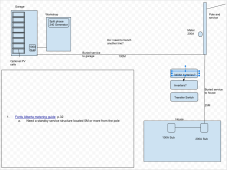hpeyerl
New Member
- Joined
- Mar 22, 2022
- Messages
- 57
I have an existing home in the forest. I recently acquired a portable office type building with an integrated 20kW 3phase-208 diesel generator. I rewired the taps on the generator so it is now split-phase 240.
Currently we experience approximately 10-15 grid outages per year, some of them as short as a few seconds, some as long as one or two days. The generator works great except it consumes a lot of diesel. Our base load is obviously nowhere near the generator's capacity so while we're asleep, our base load is on the order of 1000-1500watts (furnace fan, computers, clocks, yard light, etc).
Also, currently, I don't have an actual transfer switch; which is bad. Before I start the generator, I have to walk to the pole, turn off the main breaker at the meter, then walk 100m to turn on the generator. I hope to fix that.
I have access to telecom batteries (that are still good but get swapped out prophylactically by the cellphone provider. My friend 'disposes' of them by giving them to me).
What I think I want to do is buy something like an LVX6048, wire the grid to "AC Input", and wire my loads to "AC Output" and connect the batteries to the built in charger.
This is where the problem comes in.
My site layout looks like this:

Because the generator is integrated into my Workshop building (and weighs 1300lbs, and is noisy), I can't really move/separate it from the workshop. Thus it is presently at the end of an underground cable that goes to the Garage which is itself at the end of an underground cable that originates at the meter on the same line as my garage/office loads. This works fine in the current scenario because if I disconnect the grid at the pole and start the generator, it powers everything, including the house.
So I have thought of a number of options, none of them ideal:
1) move the generator. Yuck.
2) dig another trench or daylight the existing trench to add a dedicated generator circuit. Yuck.
3) A second inverter for just the Garage/Workshop/Generator and a transfer switch that can switch its AC Output to the AC Input of the main inverter on demand. (yuck).
If I choose option (3), then I can run off-grid when the grid goes down, using the internal transfer switch on the LVX6048. For long outages, when my batteries get low on charge, I can turn off the main breaker at the meter base, hit the transfer switch to move that whole segment onto the AC Input, start the generator, charge the batteries, shut down the generator, move the transfer switch back, turn the main breaker back on again. This will typically happen once per year.
Note: I do have a disconnect at the generator as well so I can run the generator isolated from any power circuits, for maintenance purposes. That disconnect is usually in the disconnected position anyway.
Is there a better idea I haven't thought of?
Currently we experience approximately 10-15 grid outages per year, some of them as short as a few seconds, some as long as one or two days. The generator works great except it consumes a lot of diesel. Our base load is obviously nowhere near the generator's capacity so while we're asleep, our base load is on the order of 1000-1500watts (furnace fan, computers, clocks, yard light, etc).
Also, currently, I don't have an actual transfer switch; which is bad. Before I start the generator, I have to walk to the pole, turn off the main breaker at the meter, then walk 100m to turn on the generator. I hope to fix that.
I have access to telecom batteries (that are still good but get swapped out prophylactically by the cellphone provider. My friend 'disposes' of them by giving them to me).
What I think I want to do is buy something like an LVX6048, wire the grid to "AC Input", and wire my loads to "AC Output" and connect the batteries to the built in charger.
This is where the problem comes in.
My site layout looks like this:

Because the generator is integrated into my Workshop building (and weighs 1300lbs, and is noisy), I can't really move/separate it from the workshop. Thus it is presently at the end of an underground cable that goes to the Garage which is itself at the end of an underground cable that originates at the meter on the same line as my garage/office loads. This works fine in the current scenario because if I disconnect the grid at the pole and start the generator, it powers everything, including the house.
So I have thought of a number of options, none of them ideal:
1) move the generator. Yuck.
2) dig another trench or daylight the existing trench to add a dedicated generator circuit. Yuck.
3) A second inverter for just the Garage/Workshop/Generator and a transfer switch that can switch its AC Output to the AC Input of the main inverter on demand. (yuck).
If I choose option (3), then I can run off-grid when the grid goes down, using the internal transfer switch on the LVX6048. For long outages, when my batteries get low on charge, I can turn off the main breaker at the meter base, hit the transfer switch to move that whole segment onto the AC Input, start the generator, charge the batteries, shut down the generator, move the transfer switch back, turn the main breaker back on again. This will typically happen once per year.
Note: I do have a disconnect at the generator as well so I can run the generator isolated from any power circuits, for maintenance purposes. That disconnect is usually in the disconnected position anyway.
Is there a better idea I haven't thought of?



